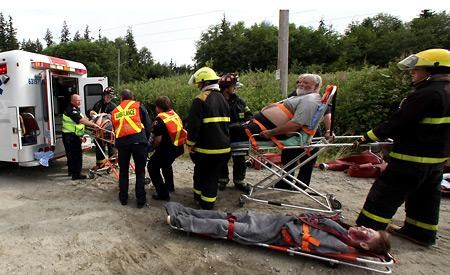Emergency lights were flashing and first responders from several different agencies were spread along a section of Joyce Avenue near Powell River General Hospital. Drivers were slowed by RCMP traffic control and pedestrians were not permitted access.
An aircraft had hit the ground, colliding with a tanker full of hydrogen peroxide, a caustic material. There were dead and injured passengers at the site, which was contaminated from the tanker chemical leakage from the accident.
This realistic accident scene was the centrepiece for a large simulation that pressed Powell River’s first responders, health care professionals and senior administrators from Powell River Regional District and City of Powell River in the emergency operations centre into full service, Friday, June 19.
The simulated accident may not have been realistic in terms of where a tanker full of hydrogen peroxide, a chemical used by Catalyst Paper Corporation, would be situated, but the desire was to hold the simulation close to the hospital.
Ryan Thoms, manager of emergency services for the Powell River Regional Emergency Program, said the exercise was an opportunity for multi-agencies to come together and practice a complicated event. Organizations and agencies such as Powell River Fire Rescue, RCMP, BC Ambulance Service, Powell River Search and Rescue, the hospital, emergency support services, Catalyst, as well as the emergency operations centre (EOC), were pressed into maximum effort to deal with the detailed and challenging scenario. The operations centre, housed in the regional district boardroom, brought together staff of local governments who have a role to play in complex emergency management in the community.
“It was an opportunity for us to put together an exercise to simulate and practice how we activate and communicate together and the inter-relationships that we have,” Thoms said.
Planning for the exercise began more than six months ago, with discussions about how to organize a complex, mass-casualty event. There was also interest from Powell River airport manager to have an aircraft incident, Thoms said.
“There had also been a discussion for a long time about wanting to practice decontamination of a hazardous material, and what can happen when hazardous materials come in contact with people, and the need to decontaminate them before transportation in ambulances to hospital,” Thoms said. “This was an opportunity to practice it live.”
Thoms was in the emergency operations centre for the entire exercise and so was not able to witness first-hand how the simulation was playing out in the field, but the site agencies, such as police, fire, ambulance, search and rescue have good people and good working relationships, he said.
“There was extra challenge for them because this simulation was bigger than usual,” he said. “Therefore, the stresses, the organization and challenges at the site level to look after the safety of the responders, deal with the incident, deal with the public safety element and forwarding information, is a tremendous challenge to complete in a short exercise.”
Thoms said the hospital had its need to test mass-casualty incidents of a certain complexity.
“We did a lot of work with hospital and health authority staff coming into this to design an exercise that would just push the limits and allow them to test their protocols for a large event,” he said. “Unfortunately, aircraft incidents frequently result in large numbers of casualties. We designed the exercise purposely to deliver what hospital management saw as the elements they wanted to test internally...They could take it right through the hospital as far as the operating room and fully test their capacity.”
Thoms said the EOC functioned really well and staff members were asked to juggle many tasks very quickly. The local government staff members involved have taken a lot of training in the past few years. The Emergency Program Act makes this mandatory for local governments to manage major incidents in their jurisdictions.



